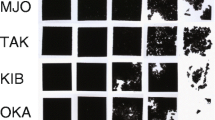Abstract
Bacterial polyhydroxyalkanoates (PHAs) are perceived to be a suitable alternative to petrochemical plastics because they have similar material properties, are environmentally degradable, and are produced from renewable resources. In this study, the in situ degradation of medium-chain-length PHA (PHAMCL) films in tropical forest and mangrove soils was assessed. The PHAMCL was produced by Pseudomonas putida PGA1 using saponified palm kernel oil (SPKO) as the carbon source. After 112 d of burial, there was 16.7% reduction in gross weight of the films buried in acidic forest soil (FS), 3.0% in the ones buried in alkaline forest soil by the side of a stream (FSst) and 4.5% in those buried in mangrove soil (MS). There was a slight decrease in molecular weight for the films buried in FS but not for the films buried in FSst and in MS. However, no changes were observed for the melting temperature, glass transition temperature, monomer compositions, structure, and functional group analyses of the films from any of the burial sites during the test period. This means that the integral properties of the films were maintained during that period and degradation was by surface erosion. Scanning electron microscopy of the films from the three sites revealed holes on the film surfaces which could be attributed to attack by microorganisms and bigger organisms such as detritivores. For comparison purposes, films of polyhydroxybutyrate (PHB), a short-chain-length PHA, and polyethylene (PE) were buried together with the PHAMCL films in all three sites. The PHB films disintegrated completely in MS and lost 73.5% of their initial weight in FSst, but only 4.6% in FS suggesting that water movement played a major role in breaking up the brittle PHB films. The PE films did not register any weight loss in any of the test sites.
Similar content being viewed by others
References
Swift, G. (1992), FEMS Microbiol. Rev. 103, 339–346.
Imam, S. H., Chen, L., Gordon, S. H., Shogren, R. L., Weisleder, D., and Greene, R. V. (1998), J. Environ. Polym. Degrad. 6, 91–98.
Imam, S. H., Gordon, S. H., Shogren, R. L., Tosteson, T. R., Govind, N. S., and Greene, R. V. (1999), Appl. Environ. Microbiol. 65, 431–437.
Lee, S. Y. (1996), Biotechnol. Bioeng. 49, 1–4.
Jendrossek, D., Schirmer, A., and Schlegel, H. G. (1996), Appl. Microbiol. Biotechnol. 46, 451–463.
Marchessault, R. H., Monasterios, C. J., Jesudason, J. J., et al. (1994), Polym. Degrad. Stab. 45, 187–196.
Brandl, H., Bachofen, R., Mayer, J., and Wintermantel, E. (1995), Can. J. Microbiol. 41(Suppl. 1), 143–153.
Tan, I. K. P., Kumar, K. S., Theanmalar, M., Gan, S. N., and Gordon III, B. (1997), Appl. Microbiol. Biotechnol. 47, 207–211.
Ho, Y. H., Gan, S. N., and Tan, I. K. P. (2002), Appl. Biochem. Biotechnol. 102–103, 337–347.
American Society for Testing and Materials (ASTM). (1992), in Annual Book of ASTM Standards, ASTM, Philadelphia, pp. 815–818.
Doi, Y., Kawaguchi, Y., Nakamura, Y., and Kunioka, M. (1989), Appl. Environ. Microbiol. 55, 2932–2938.
Lageveen, R. G., Huisman, G. W., Preusting, H., Ketelaar, P., Eggink, G., and Witholt, B. (1988), Appl. Environ. Microbiol. 54, 2924–2932.
Rowell, D. L. (1996), Soil Science: methods and applications, Longman, Singapore, pp. 153–161.
Braunegg, G., Sonnleitner, B., and Lafferty, R. M. (1978), Eur. J. Appl. Microbiol. Biotechnol. 6, 29–37.
Nishida, H. and Tokiwa, Y. (1993), J. Environ. Polym. Degrad. 1, 65–80.
Mergaert, J., Webb, A., Anderson, C., Wouters, A., and Swings, J. (1993), Appl. Environ. Microbiol. 59, 3233–3238.
Timmins, M. R. and Lenz, R. W. (1994), in Trends in polymer science, Vol. 2, Hawthorne, W., ed., Elsevier Science Ltd., UK, pp. 15–19.
Mergaert, J., Wouters, A., Anderson, C., and Swings, J. (1995), Can. J. Microbiol. 41(Suppl. 1), 154–159.
Doi, Y., Kasuya, K., Abe, H., et al. (1996), Polym. Degrad. Stab. 51, 281–286.
Tsuji, H. and Suzuyoshi, K. (2002), Polym. Degrad. Stab. 75, 357–365.
Tsuji, H. and Suzuyoshi, K. (2002), Polym. Degrad. Stab. 75, 347–355.
Gross, R. A., Demello, C., Kenz, R. W., Brandl, H., and Fuller, R. C. (1989), Macromolecules 22, 1106–1115.
Preusting, H., Nijenhuie, A., and Witholt, B. (1990), Macromolecules 23, 4220–4224.
Author information
Authors and Affiliations
Corresponding author
Rights and permissions
About this article
Cite this article
Lim, SP., Gan, SN. & Tan, I.K.P. Degradation of medium-chain-length polyhydroxyalkanoates in tropical forest and mangrove soils. Appl Biochem Biotechnol 126, 23–33 (2005). https://doi.org/10.1007/s12010-005-0003-7
Received:
Revised:
Issue Date:
DOI: https://doi.org/10.1007/s12010-005-0003-7




